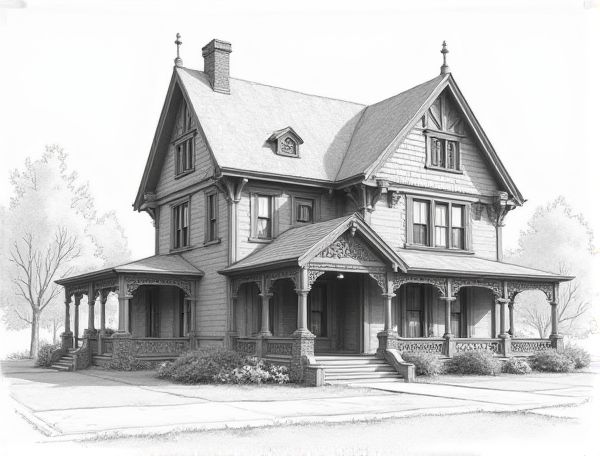
Photo illustration: Victorian home design with wheelchair accessibility
Victorian home design can be thoughtfully adapted to enhance wheelchair accessibility by incorporating wider doorways, ramped entrances, and open floor plans without compromising the intricate architectural details that define this style. Explore how you can blend historic charm with modern functionality to create a beautiful and accessible living space in the full article.
Introduction to Victorian Home Design with Wheelchair Accessibility
Victorian home design features ornate detailing, steep gable roofs, and vibrant color schemes that create a distinctive historic charm. Integrating wheelchair accessibility in these homes involves widening doorways, installing ramps, and modifying bathrooms to meet ADA standards without compromising the architectural character. Thoughtful adaptations ensure that Victorian aesthetics harmonize with modern accessibility requirements for inclusive living spaces.
Key Principles of Accessible Victorian Architecture
Victorian architecture emphasizes intricate details, steep gable roofs, and vibrant color palettes, which can be adapted for accessibility by incorporating wider doorways and ramps to accommodate mobility needs. Your design should prioritize easy navigation with level floors and strategically placed handrails while preserving the ornate trim and stained-glass windows iconic to the style. Balancing historical aesthetics with modern accessibility standards ensures a beautifully functional home for all occupants.
Integrating Ramps and Step-Free Entrances Gracefully
Integrating ramps and step-free entrances gracefully enhances your home's accessibility without compromising aesthetic appeal, using materials and design elements that complement existing architecture. Thoughtful placement and subtle transitions ensure seamless mobility for all individuals, improving safety and inclusivity while maintaining stylish functionality.
Adapting Doorways and Hallways for Mobility
Adapting doorways and hallways for mobility involves widening entrances to at least 32 inches to accommodate wheelchairs and walkers comfortably. Installing lever-style door handles enhances ease of use for individuals with limited hand strength or dexterity. Your home's accessibility improves significantly by ensuring hallways are free of clutter and wide enough, typically 36 inches, to allow safe and unobstructed movement.
Accessible Kitchen Design in Victorian Homes
Accessible kitchen design in Victorian homes enhances your cooking experience by integrating modern ergonomic features while preserving historical charm. Custom cabinetry with pull-out shelves, adjustable countertops, and widened doorways ensure seamless mobility and ease of use. Thoughtful lighting and layout modifications improve safety and functionality without compromising the vintage aesthetic.
Stylish, Barrier-Free Bathrooms with Victorian Charm
Create stylish, barrier-free bathrooms that seamlessly blend modern accessibility with timeless Victorian charm, featuring elegant fixtures, clawfoot tubs, and intricate tile patterns. Your design will enhance comfort and sophistication, ensuring every detail reflects both functionality and classic aesthetic appeal.
Incorporating Elevators and Stair Lifts Discreetly
Incorporating elevators and stair lifts discreetly into your home design enhances accessibility without compromising aesthetic appeal. Custom-built shafts and concealed fittings allow these features to blend seamlessly with architectural elements, ensuring both functionality and elegance.
Flooring Solutions for Safety and Authentic Style
Choose flooring solutions that combine safety features like slip resistance and durability with authentic materials such as natural hardwood or textured stone to enhance your home's style. Properly installed flooring not only prevents accidents but also adds a unique aesthetic appeal that complements your interior design theme. Investing in quality flooring ensures your living space remains both secure and visually striking for years to come.
Preserving Historical Aesthetics While Enhancing Functionality
Maintaining the integrity of historical aesthetics in your home design ensures that timeless architectural details and period-appropriate materials are preserved, enriching the overall character and cultural value. Incorporating modern functionality, such as energy-efficient systems and smart home technology, seamlessly enhances comfort and convenience without compromising the original style. Your renovation project balances respect for heritage with the practical needs of contemporary living, creating a harmonious and enduring space.
Expert Tips for a Cohesive, Wheelchair-Friendly Victorian Home
Incorporate wide doorways and smooth flooring materials such as hardwood or low-pile carpet to ensure seamless wheelchair mobility throughout a Victorian home. Utilize built-in cabinetry and adjustable-height countertops to maintain the classic Victorian aesthetic while enhancing accessibility and functionality for wheelchair users.
 homedesy.com
homedesy.com